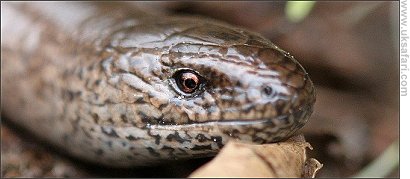
|

|
|
 Sent
to you Sent
to you
by e-mail
|
|
Simply
enter your details and hit the send button
more
info |
|


Click Here

Links
Advertise
Terms of Use
Contributors
About Us
Contact Us
|
 |
Go back
 | Bookmark
| Bookmark
 | Print Page
| Print Page  | E-Mail Us
| E-Mail Us 
Handle
With Care
____________________________________________________
Posted: 1st April 2008

Photo: Dean Eades |
It's no co-incidence that slow-worms are coming out of hibernation now. They time their wake up perfectly in sync with the abundance of juicy slugs which are about now. Slow-worms don't want to miss out on this slimy free food fest.
Incidentally, whoever named them slow-worms would have made a great politician. Slow-worms aren't worms, and they're not particularly slow either. They are of course lizards without legs, which makes them look a lot like
snakes! Curiously, they have another common name which is the 'Blind Worm'.
That's right... they're not blind either.
Any fear people have of slow-worms is usually as a result of this snake-like appearance. But if you look closely at a slow-worm you'll notice they have moveable eyelids, allowing them to blink. Something which
you don't find on snakes. Slow-worms also have a notched tongue, rather than a forked tongue like a snake.
People with slow-worms in their gardens sometimes write to us with concerns
that they may be bitten if they handle them. Slow-worms can bite, but they
are not venomous. In fact it's usually the slow-worms which are in danger of injury. As their Latin name
Anguis fragilis suggests, they really are quite fragile creatures and need to be handled with care. Slow-worms have developed a defence mechanism,
known in scientific circles as caudal
autotomy, where if you try to grab one roughly by its tail, it will literally snap off in your hand. You'll be left holding the wriggling tail, while the rest of the slow-worm makes a hasty retreat. If you do need to pick one up, do it carefully.
Slow-worms generally mate between April and June, and the young are born in late August or September. The females are ovoviviparous, which simply means that the eggs hatch inside the mothers body. It's very rare for the eggs to be laid before they hatch. The young usually come out of their mothers wriggling, and are able to fend for themselves from birth.
In recent years slow-worm numbers have declined dramatically, mainly as a result of habitat loss and intensive land-use. The remaining populations
in allotments and gardens are now especially important to the survival of this species. They are really beneficial to gardens as they eat a variety of pests, so if you have any, please look after them.
 Helping slow-worms in your garden:
Helping slow-worms in your garden:
• Allow a patch of grass to grow wild. Slow-worms love this habitat.
• Piles of stones, old rubber backed carpet tiles, old metal oven trays, black plastic sheeting or anything which retains heat
can also attract slow-worms.
• Before mowing/strimming, check the area to be cut for wildlife by walking through it.
• Build a log pile in a shaded part of the garden to provide food, shelter
and hibernation for slow-worms.
• Avoid the use of slug pellets - slow-worms could eat the poisoned slugs.
• Have a compost heap which allows slow-worms to crawl through it and feed inside.
• Always check your heap before spearing it with a garden fork
• Keep cats away from areas where they are known to exist
Related Links:
UK Safari Slow-worm Fact File
Weapons of Mass De-Slugging
UK Safari Reptile Section
UK Safari News
|
 |

Identification
Charts

Amphibians

Garden Birds

Mammals

Mammal Tracks

Butterflies

Spiders
more here >
|